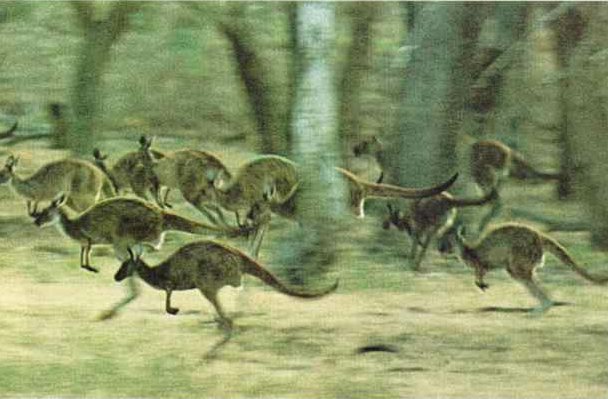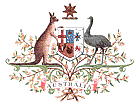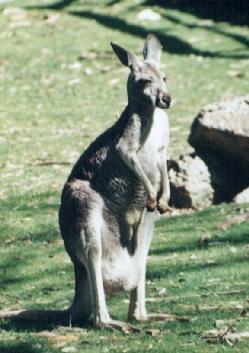|
|
| Name: Gray Kangaroo |
| Scientific Name: Macropus giganteus |
| Range: Eastern third of Australia |
| Habitat:Mountain forest and scrub. |
| Status: Not threatened |
| Diet in the Wild: Grass and some herbaceous plants. |
| Diet in the Zoo: Many types of hay -- Alfalfa, clover, timothy and some processed grains. |
| Physical
description:
The Gray Kangaroo can grow up to 6 ft in height , weigh 200lbs and have a tail that can be 4 feet in length. The gray Kangaroo has a small head and large ears. Kangaroos also have a large claw on their hind legs that is a valuable in defending themselves. |

UIUC
College of Agricultural, Consumer and Environmental Sciences
| Comments about
the Kangaroos at the Fort Worth Zoo
The gray kangaroos at the Fort Worth Zoo are no
longer on exhibit.
|

| General
information:
The Gray Kangaroo is a native animal of Australia. The kangaroo has played an important part in the history of Australia. In the days of the dream time with the aborigines the kangaroo was a main food source and the encouraged the creation of a famous Australian item, the boomerang. The boomerang was better than the spear because if you missed your target it would hopefully come back to you. The kangaroo's numbers in Australia are stable since the extermination of its natural predator, the Tasmanian Wolf. The Eastern Gray Kangaroo can be found in the eastern third of the Australian Continent, especially along the coast in damp forest and scrub habitat. The Gray Kangaroo or Forester can be found on the crest of Australia which can be found on the baggy green cap of the Australian cricket team and on the cover of the Australian passport. The male kangaroo is known as a Boomer, the female as a Flyer and the young kangaroo as a Joey. Even though these animals look cuddly they are to be approached with caution because of a large claw on the hind legs that have sent many a tourist running away injured. |
| Special
anatomical, physiological or behavioral adaptations:
The ancestors of the kangaroos may have been tree-dwellers like modern tree kangaroos, opossums or koalas. The Gray Kangaroo is able to hop an amazing distance. They use this as their first line of defense. Kangaroos have been seen to leap over fences or cars and their leaps have been reported to have reached lengths of 26 feet and 10 feet in height. The males usually form a loose harems in order to breed but then move off and join a group of males for a while. The embryo from the female Kangaroo is the size of a pea at birth. Several days before birth the female begins the task of cleaning out her pouch until it is free of debris. The joey will remain in the pouch attached to the nipple of the mother for nine months. The female has four nipples in the pouch, one for a different stage in the growing process. The joey will play peek-a-boo while gaining courage to enter the new world. This is done by hanging the joey's ear out of the top of the pouch like a handkerchief. Once the joey starts to wander into the new world it is helped getting in and out of the pouch by a group of muscle s that the female has in the opening of the pouch. In the morning a family of Kangaroos will sometimes go to a water hole and line up and take turns bathing and washing their teeth with their paws. They also thoroughly clean their ears, faces, bellies and backs. |

UIUC
College of Agricultural, Consumer and Environmental Sciences
| Personal
Observations:
I have seen many kangaroos in Australia (my home country) and they seem to move in families and the elders protect the young Joey's against all comers even other kangaroos. I have witnessed kangaroos boxing against each other. This is done between the males when they find one female and normally the stronger gets to mate with the female. |
| Page author: Jason Read
j_read@hotmail.com |
| Source of information:
Grey Kangaroo
First emergence From the Pouch
Courtship and Mating
Australian Animals
The First Australians
|
|
WhoZoo Home |
|
|
|
|
|
|